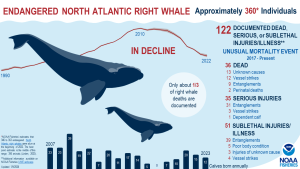Winter in Florida usually means that visitors from northern states come here to escape colder weather. More exciting for us, though, are the visitors we see in our waters! Pregnant North Atlantic Right Whale females migrate from their northern feeding grounds to waters off the coast of Georgia and Florida every year from November to April to give birth to their young. This area off our coast is the only known calving ground for the North Atlantic Right Whale.
The North Atlantic Right Whale
The North Atlantic Right Whale, Eubalaena glacialis, is one of the most endangered large whales in the world. Approximately 360 individuals remain, so researchers closely monitor the females and their calves during the calving season. In 1994, the National Marine Fisheries Service designated the waters off the coasts of Florida and Georgia as right whale critical habitat. This designation provides more protection for the right whales while they are in these areas. Researchers from the Fish and Wildlife Research Institute of FWC, the Georgia Department of Natural Resources, and the New England Aquarium fly Early Warning System aerial surveys to locate females and their calves during the winter calving season.

So far in the 2024 calving season, 14 females and their calves have been sighted and photographed. Each right whale is catalogued and has a name and/or number. Researchers can identify right whales by the pattern of callosity (large patches of raised tissue) on their heads and other scars on their bodies. The pattern is unique to each whale. Because of this, females can be identified, and calves documented. Researchers also often know how old a right whale is and how many calves they have given birth to in the past.
Females and their calves often stay close to shore in shallow water. This makes it easy for people to see right whales from the beach. Many people are involved in the right whale sighting network, reporting when they see right whales off the coast. This helps to send alerts to nearby ships so they can steer clear of females and their calves. You can report sightings of right whales by calling 888-97-WHALE or 877-WHALE-HELP. Right whales have a distinctive V-shaped blow as they breathe when they come to the surface. They also do not have a dorsal fin. These distinctions help to identify them when you’re looking from far away.
What can you do to help?
Every individual right whale born and that survives is important for the species’ recovery. Unfortunately, North Atlantic right whales are dying faster than they can reproduce. The primary causes of death are entanglements in fishing gear and collisions with boats and large ships.
- Go slow, 10 knots or slower, in your boat if you’re in an area where females and their calves have been sighted.
- Stay alert and post a lookout to scan the water for right whales. Females and their calves often hang out at the surface, so going slow and keeping a lookout can help avoid collisions with whales.
- Use the WhaleAlert app on your phone or look at the recent whale sightings near your location before heading out so you know where right whales have been sighted. You can also report whale sightings through the WhaleAlert app.
- Keep your distance and give whales their space. Stay 500 yards away from any whales. Federal law requires vessels, paddle boarders, and aircraft (including drones) to stay at least 500 yards (five football fields) away from right whales.
- Report sightings by calling 888-97-WHALE or 877-WHALE-HELP or, if on your boat, to the Coast Guard on marine VHF channel 16. Please take a photo if you can and note the GPS coordinates.
- Follow NOAA Fisheries Service on Facebook and Instagram for sighting updates of North Atlantic right whale females and their calves.
Featured Image Credit:
Right whale Catalog #3546 ‘Halo’ and calf sighted approximately 8NM miles off St. Catherine’s Island, GA on January 14, 2024. Catalog #3546 is 19 years old and this is her third calf. Photo taken by Clearwater Marine Aquarium Research Institute under NOAA permit 26919.
References
2023-2024 right whale calving season. (n.d.). Flickr. Retrieved January 24, 2024, from https://www.flickr.com/photos/myfwc/albums/72177720313302771/
About right whales. (n.d.). Florida Fish and Wildlife Conservation Commission. Retrieved January 24, 2024, from https://myfwc.com/research/wildlife/right-whales/about/
Early warning system. (n.d.). Florida Fish and Wildlife Conservation Commission. Retrieved January 24, 2024, from https://myfwc.com/research/wildlife/right-whales/early-warning-system/
Fisheries, N. (n.d.). North Atlantic Right Whale Calving Season 2024. NOAA. Retrieved January 24, 2024, from https://www.fisheries.noaa.gov/national/endangered-species-conservation/north-atlantic-right-whale-calving-season-2024
Identifying right whales – New England Aquarium. (2023, July 10). New England Aquarium. Retrieved January 24, 2024, from https://www.neaq.org/conservation-and-research/anderson-cabot-center-for-ocean-life/identifying-right-whales/
North Atlantic Right Whale – New England Aquarium. (2023, September 7). New England Aquarium. Retrieved January 24, 2024, from https://www.neaq.org/animal/right-whales/
North Atlantic Right Whale Catalog. (n.d.). Retrieved January 24, 2024, from https://rwcatalog.neaq.org/#/
North Atlantic Right Whales | Department of Natural Resources Division. (n.d.). Retrieved January 24, 2024, from https://gadnr.org/conservation/rightwhales
Right whales. (n.d.). Florida Fish and Wildlife Conservation Commission. Retrieved January 24, 2024, from https://myfwc.com/research/wildlife/right-whales/
Whale Alert. (n.d.). Whale Alert. Retrieved January 24, 2024, from https://www.whalealert.org/
WhaleMap. (n.d.). Retrieved January 24, 2024, from https://whalemap.org/
 0
0
